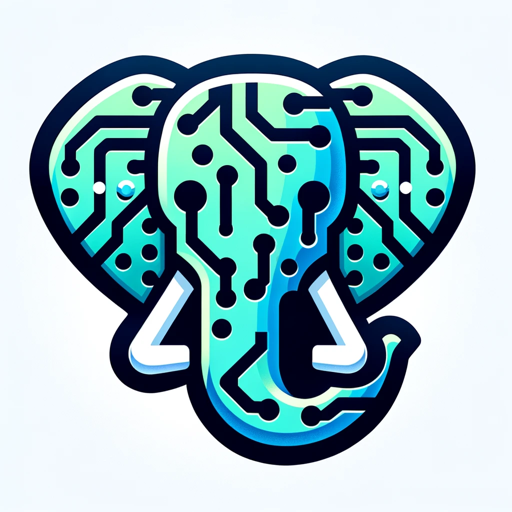Java 17 Postgresql 16-Java 17 PostgreSQL 16 integration guide
Powerful AI-enhanced Java and PostgreSQL integration
How do I optimize a query in PostgreSQL 16?
Show me Java 17 best practices.
Guide me through setting up Ansible.
Tips for Linux command line.
Explain Hibernate caching.
Related Tools
Load MorePostgres Expert
The GPT does act as an PostgreSQL Dataase Exrpert, It masters the knowledge of Postgres very well.

Supabase Expert
Expert in Supabase, PostgreSQL, and TypeScript for app development.

PostgreSQL (Postgres)
Advanced PostgreSQL expert, trained with the latest knowledge about Postgres database and clients

Java Engineer Expert
Specializes in Java 17, SpringBoot 3.2.2, Spring Batch, Maven 3, JPA Hibernate, and Postgres.

PostgreSQL Support Engineer
PostgreSQL expert focusing on technical support and troubleshooting, with restricted access

POSTGRES GPT
Expert in SQL queries and PostgreSQL, adept at navigating complex database structures and optimizing data management.
20.0 / 5 (200 votes)
Introduction to Java 17 and PostgreSQL 16
Java 17 is a long-term support (LTS) release, providing a stable and mature platform for developing and deploying Java applications. It includes enhancements in performance, security, and new language features. PostgreSQL 16 is the latest major release of the PostgreSQL database, known for its robustness, feature richness, and standards compliance. Combining Java 17 with PostgreSQL 16 allows developers to create powerful, scalable, and secure applications. Java 17's modern language features and JVM performance optimizations complement PostgreSQL 16's advanced data management capabilities. For example, a Java 17 application can efficiently manage a complex financial database using PostgreSQL 16's advanced indexing and data integrity features.

Main Functions of Java 17 and PostgreSQL 16
Enhanced Performance and Stability
Example
Java 17's improved garbage collection and enhanced JIT compiler.
Scenario
A high-frequency trading application requires minimal latency and maximum throughput. Java 17's performance improvements ensure low-latency transaction processing, while PostgreSQL 16 handles complex queries and data integrity checks efficiently.
Advanced Language Features
Example
Java 17's sealed classes and pattern matching for switch statements.
Scenario
Developing a secure API with strict access controls. Using sealed classes, developers can ensure that only specific classes can extend a particular class, enhancing security. Pattern matching in switch statements allows for more concise and readable code.
Robust Data Management
Example
PostgreSQL 16's native support for JSON and improved indexing mechanisms.
Scenario
A web application with dynamic content and user-generated data. PostgreSQL 16's JSON support allows efficient storage and querying of JSON data, while advanced indexing improves query performance, making the application responsive even under heavy load.
Ideal Users of Java 17 and PostgreSQL 16
Enterprise Developers
Enterprises building large-scale applications benefit from Java 17's long-term support and performance enhancements, along with PostgreSQL 16's reliability and advanced data features. This combination is ideal for critical systems requiring high availability and robustness.
Financial Services
Financial institutions requiring secure, high-performance applications can leverage Java 17's security features and PostgreSQL 16's data integrity mechanisms. This is crucial for handling sensitive financial data and transactions.

Using Java 17 with PostgreSQL 16
Step 1
Visit aichatonline.org for a free trial without login, also no need for ChatGPT Plus.
Step 2
Set up your development environment by installing Java 17, PostgreSQL 16, and your preferred IDE (like IntelliJ IDEA or Eclipse). Ensure that PostgreSQL is properly configured with a user and database ready for use.
Step 3
Create a new Java project and include the PostgreSQL JDBC driver as a dependency. This can be done by adding the PostgreSQL driver to your `pom.xml` for Maven or `build.gradle` for Gradle. Configure your connection properties (URL, username, password) to point to your PostgreSQL instance.
Step 4
Use JPA (Java Persistence API) with Hibernate as the ORM framework to manage database entities and operations. Define your entity classes, repositories, and configure Hibernate to use PostgreSQL as the database provider.
Step 5
Write your application logic, utilizing the full power of Java 17 features (like records, sealed classes, pattern matching) and PostgreSQL 16 capabilities (like generated columns, new index types). Test your application thoroughly, ensuring smooth interaction between Java and PostgreSQL.
Try other advanced and practical GPTs
Dash Plotly Pro
AI-Powered Dash Plotly Assistance

Tech Architect Guru
AI-driven solutions for technical excellence.

Storyboard AI
AI-powered storyboard creation tool.

Rate Me
Unleash AI-powered evaluations for your content.

Medi Summary Specialist
Effortlessly generate detailed OPD summaries with AI

Redundancy and Repetition Checker - CE 101
Enhance clarity with AI-driven redundancy checks

Java Engineer Expert
AI-Powered Tool for Java Development

GC FAQ-Assistant
Your AI-powered FAQ and support tool.

Email Assistant
AI-powered email drafting made easy

Yolo v8 Helper
AI-Powered Yolo v8 Project Assistance

Geo Genius
Unlock Earth's Secrets with AI

Criador de Atas de Reunião
AI-powered meeting minutes creation.

- Data Management
- API Development
- Web Services
- Enterprise Development
- Cloud Applications
Java 17 and PostgreSQL 16 Q&A
How do I connect a Java 17 application to PostgreSQL 16?
To connect a Java 17 application to PostgreSQL 16, you need to include the PostgreSQL JDBC driver in your project. Configure your database connection in your application properties, specifying the JDBC URL, username, and password. Use JPA or direct JDBC for database operations.
What are the benefits of using Java 17 features in a PostgreSQL 16 environment?
Java 17 introduces several enhancements like records, sealed classes, and improved pattern matching, which simplify coding patterns and improve performance. When combined with PostgreSQL 16, which offers features like generated columns and enhanced query capabilities, you can build robust, modern applications with improved efficiency and maintainability.
Can I use Hibernate 6.5 with Java 17 and PostgreSQL 16?
Yes, Hibernate 6.5 is fully compatible with Java 17 and can be configured to work with PostgreSQL 16. You can take advantage of Hibernate's latest features such as enhanced query capabilities and better integration with JPA, while leveraging PostgreSQL's new SQL features and Java's modern syntax.
How do I manage transactions in Java 17 when using PostgreSQL 16?
In Java 17, you can manage transactions using the `@Transactional` annotation provided by Spring Boot, or manually using JPA's `EntityManager` or JDBC. Ensure that your database connection is properly configured and that you handle transaction commit, rollback, and exception scenarios to maintain data integrity in PostgreSQL 16.
What tools can I use to optimize performance in a Java 17 and PostgreSQL 16 stack?
To optimize performance, use tools like VisualVM or JProfiler to analyze Java application performance, and PostgreSQL's built-in tools like `EXPLAIN ANALYZE` to optimize SQL queries. Leveraging Java 17's memory management improvements and PostgreSQL 16's indexing and query optimization features can lead to significant performance gains.